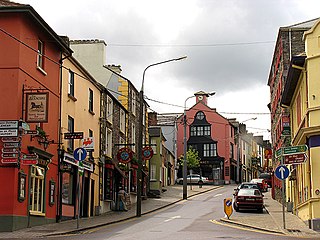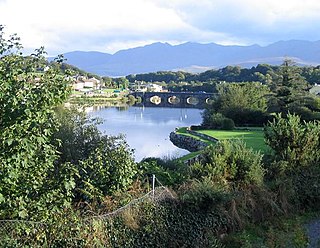Related Research Articles

Killorglin is a town in County Kerry, Ireland. As of the 2016 CSO census, the town's population was 2,199. Killorglin is on the Ring of Kerry tourist route, and annual events include the August Puck Fair festival, which starts with the crowning and parading of a "king" wild goat.

The River Laune is a river in County Kerry, Ireland, which flows from Lough Leane, one of the Lakes of Killarney, through Beaufort, past Ballymalis Castle, through the town of Killorglin, and empties into the sea, first at Castlemaine harbour beside the river Maine and then out through Dingle Bay. The Laune is well known for salmon and trout fishing.

Blennerville is a small village near Tralee, County Kerry, Ireland. It is approximately 1 mile (1.6 km) west of the town centre on the N86 road to Dingle, where the River Lee enters Tralee Bay. The village was formerly Tralee's port, and is connected to the town centre by the Tralee Ship Canal. Part of Blennerville electoral division falls within the area of Tralee Town Council, and at the 2011 census had a population of 141. The remaining portion, outside the urban boundaries, had a 2011 population of 556.

Beaufort is a small village that lies on the banks of the River Laune in County Kerry, in the southwest of Ireland. It consists of a post office, three public houses, one supermarket, parish hall, guest houses and thirty private houses. As of the 2016 census, the population was 251. Beaufort sits at the foot of Ireland's highest mountain Carrantuohill.
The High Sheriff of Kerry was the British Crown's judicial representative in County Kerry, Ireland from the 16th century until 1922, when the office was abolished in the new Free State and replaced by the office of Kerry County Sheriff. The sheriff had judicial, electoral, ceremonial and administrative functions and executed High Court Writs. In 1908, an Order in Council made the Lord-Lieutenant the Sovereign's prime representative in a county and reduced the High Sheriff's precedence. However, the sheriff retained his responsibilities for the preservation of law and order in the county. The usual procedure for appointing the sheriff from 1660 onwards was that three persons were nominated at the beginning of each year from the county and the Lord Lieutenant then appointed his choice as High Sheriff for the remainder of the year. Often the other nominees were appointed as under-sheriffs. Sometimes a sheriff did not fulfil his entire term through death or other event and another sheriff was then appointed for the remainder of the year. The dates given hereunder are the dates of appointment. All addresses are in County Kerry unless stated otherwise.

Lieutenant-Colonel William Collis Spring was an Anglo-Irish British Army officer of the Napoleonic Wars.

Killagha Abbey of Our Lady of Bello Loco, also called Kilcolman Abbey, is a ruined Augustinian abbey and former manor house in County Kerry, Ireland. The abbey is situated one and a half miles north-west of Milltown on the banks of the River Maine.

Robert Blennerhassett was an Anglo-Irish soldier and politician.
Walter Spring the Unfortunate was an Anglo-Irish Roman Catholic landowner involved in the Irish Confederate Wars.
Thomas Spring of Castlemaine was an English Protestant soldier, politician and Constable of Castle Maine in County Kerry, Ireland.
Thomas Mullins, 1st Baron Ventry was an Anglo-Irish politician and peer.
John Blennerhassett was an Anglo-Irish member of the Irish House of Commons.
Conway Blennerhassett KC was a member of the Irish House of Commons.
Colonel Sir Rowland Blennerhassett, 1st Baronet was an Anglo-Irish lawyer and baronet.

The Blennerhassett family is an English and Anglo-Irish noble family which has been involved in the politics of the Britain and Ireland since the fourteenth century. The male line of the family is extinct in Britain.

The Farranfore–Valentia Harbour line was a 39.5 miles (63.6 km) long single-track broad gauge railway line that operated from 1892 to 1960 along Dingle Bay's southern shore in Ireland. It was the most westerly railway in Europe.


Ballymalis Castle is a tower house and National Monument located in County Kerry, Ireland.

Ardfert Abbey, also known as Ardfert Friary, is a ruined medieval Franciscan friary and National Monument in Ardfert, County Kerry, Ireland. It is thought to be built on the site of an early Christian monastic site founded by Brendan the Navigator. The present remains date from the mid-thirteenth century, with the residential tower being added in the 15th century. The friary was dissolved in 1584.

Upperthird or Upper Third is a barony in County Waterford, Ireland.
References
- ↑ Castle Conway, from 'Historic houses and castles', ireland.com http://www.ireland.com/en-us/what-is-available/attractions-built-heritage/historic-houses-and-castles/destinations/republic-of-ireland/kerry/killorglin/all/1-48998
- ↑ Michael C. O'Laughlin, Families of Co. Kerry, Ireland (Irish Roots Cafe, 1994), 30.
- ↑ Michael C. O'Laughlin, Families of Co. Kerry, Ireland (Irish Roots Cafe, 1994), 30.
- ↑ Blennerhassett family tree and information http://www.blennerhassettfamilytree.com/pages/BH07_Killorglin_K.pdf (Accessed 25 February 2013)
- ↑ Killorglin Town, Kerry County Council information http://www.kerrycoco.ie/en/allservices/planning/planspolicies/localareaplans/killorglinfunctionalarealap/thefile,3385,en.pdf Archived 2016-03-04 at the Wayback Machine (Accessed 25 February 2014)
